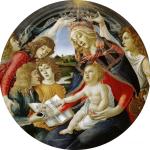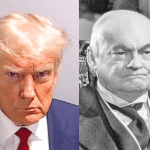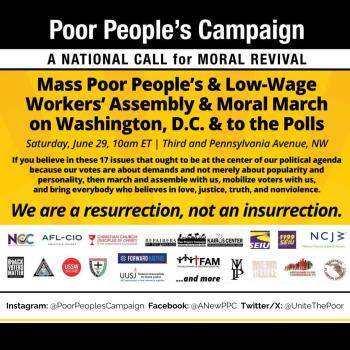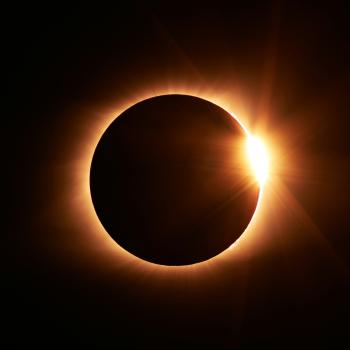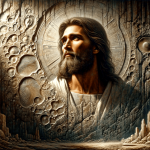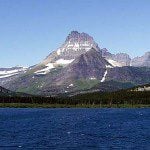Dec. 17, 1903 – The Wright Brother’s First Flight
(Excerpted from Soar to Success the Wright Way.)
The morning of Thursday, Dec. 17 dawned cold. A thin layer of ice covered the puddles of rainwater in the sand. The days were getting colder and the wind blowing from the north at a dangerous 20 to 27 miles per hour. Brothers Wilbur and Orville Wright reasoned that the next day’s weather could be even worse and that if they wanted to be home by Christmas, now was the time.
They raised the signal flag and again men from the Kill Devil Life Saving Station came over, bringing with them an area businessman and a local teenager. Again the men laid out the rails for the Junction Railway and slowly worked the machine into position. It was too cold to go too far, so they laid the starting rail only about 100 to 200 feet from the cabin.
Orville pointed the box camera at the end of the rail. He showed lifesaving crew member John Daniels how to squeeze the rubber bulb that would flip the shutter when the Flyer reached the end of the rail, and then walked over to join his brother.
The Flyer’s right wing was clamped to a bench to keep it steady while they made the final adjustments and used the battery to start the engine. Each brother spun a propeller and the engine coughed to life.
They were probably nervous. They were definitely cold, but for whatever reason, the moment grew somber. Both men had every reason to be confident they would succeed, but they were about to attempt the impossible and they knew it. As the men of the lifesaving station looked on, the Wrights stepped around the roaring machine. Will gave his younger brother advice, reminding him that the rudder was out of balance and not to over correct the controls.
“After a while they shook hands, and we couldn’t help notice how they held on to each other’s hand, sort o’ like they hated to let go; like two folks parting who weren’t sure they’d ever see each other again,” Daniels said.
Orville climbed aboard the machine and got into position. Perhaps it was the cold or the seriousness of the moment, but Wilbur asked the solemn crewmen to cheer for his brother as Orville made his final preparations.
It was 10:35 as Wilbur walked to the right wing and removed the clamp holding it to the bench. The engine roared and vibrated as the two propellers thrashed the air. The brothers looked at each other a last time, Orville released the wire and the machine lumbered slowly down the track. With the 20 mph wind blowing in their faces, Will had no trouble keeping up with the machine as it moved forward. He ran alongside for 10 or 15 steps, a hand on the strut to steady the machine as it gained speed.
After about 40 feet, Orville moved the control bar down, the forward rudder rose, and ever so slowly the machine lifted off the ground.
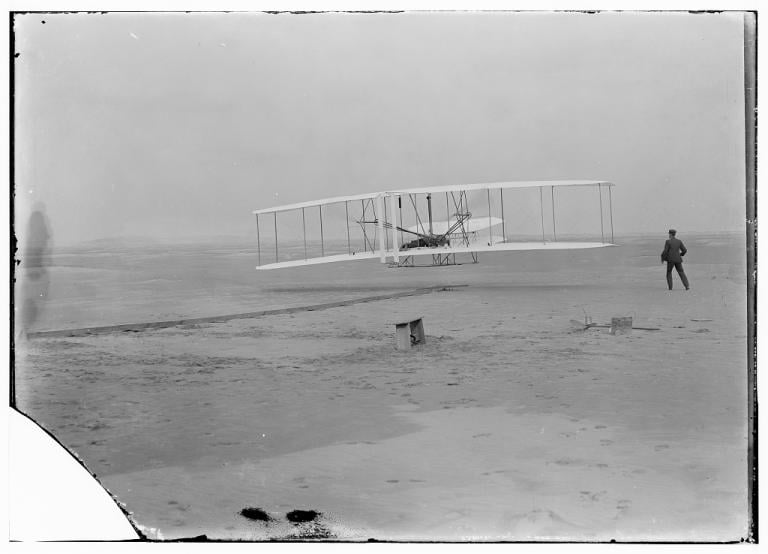
Flight.
Will stopped running and watched as the Flyer gently climbed into the air. In his excitement, he forgot to start the stopwatch in his hand. The cold wind whipped his jacket as he stood and watched the massive machine fly about 10 feet above the ground. The roaring of the propellers, the pounding engine and the steady wind filled his ears. For 12 long seconds he was transfixed. The dreamer, the experimenter, the businessman, the brother, stood in awe as his dream became a reality.
Flight.
At six-foot-two and 240 pounds, lifesaver John Daniels lived life close to the edge, facing danger and challenging death to save shipwrecked sailors. With ice-cold nerves he didn’t hesitate when he saw the world’s first airplane slowly leave the surface of the earth. His rough, weather-worn hand squeezed the bulb, and captured forever the moment when the impossible was made possible.
Flight.
Because of the wind and the poorly balanced rudder, the machine was difficult to control. After 12 seconds and about 120 feet, a sudden burst of wind sent the machine darting to the ground. Factoring the velocity of the wind and the speed of the Flyer, it was the equivalent of a flight of 540 feet in calm air, Orville later said.
“This flight lasted only 12 seconds,” Orville said, “but it was nevertheless the first in the history of the world in which a machine carrying a man had raised itself by its own power into the air in full flight, had sailed forward without reduction of speed, and had finally landed at a point as high as that from which it started.”
Flight.
Nearly everyone in the world knew human flight was impossible. It was a certainty. They didn’t think it was impossible, they knew it wasn’t possible. A few broad-minded adventurers, experimenters and inventors thought flight was possible, but they had no idea how it could be done. Seven men witnessed the “impossible” with their own eyes, and two more men with spyglasses watched from their posts at lifesaving stations down the beach. Two men on the planet knew precisely how to leave the surface of the planet, and they intended to do it again and again.
They flew three more times that day, and each flight was more successful than the previous. After briefly repairing a cracked skid under the rudder, and stepping inside to warm up, it was Wilbur’s turn. About an hour after his brother, around 11:20, Wilbur took his flight into history. Up and down, buffeted by the wind gusting and blowing from first the left, then the right, he struggled to control the machine and finally landed around 195 feet away.
Like the time before, the men of the lifesaving station helped muscle the machine back to the starting rail, and then they all went into the building to get warm. The brothers and their five visitors huddled around the stove discussing their success. The men were experiencing history in the making, and they would remember these moments for the rest of their lives.
Around 11:40 a.m. Orville climbed aboard for another ride. He was already gaining confidence from his first flight and he started out steadier. He’d covered around 200 feet when a sudden gust lifted the Flyer 12 to 15 feet into the overcast sky and slide it sideways. He reacted instantly, directing it down and back to the right. The wing tip struck, and his 15 second flight was over.
They quickly moved the machine into place for Wilbur’s second flight. Shortly before noon, he lifted off again.
“The first few hundred feet were up and down, as before, but by the time three hundred feet had been covered, the machine was under much better control,” Orville said later.
Four hundred feet. Five hundred feet. Twenty seconds. Six hundred feet. Thirty seconds. Seven hundred feet. The Flyer grew smaller in the distance as it flew above the sand; The sound of the engine growing faint across the open expanse. Forty seconds. Eight hundred feet. Forty-five seconds.
Perhaps in the excitement of the moment, young Johnny Moore ran down the beach after the airplane as it flew away. Fifty seconds. Eight hundred fifty feet. Fifty-five seconds. Suddenly the machine darted up, down, and then smashed hard into the sand, crushing the frame supporting the rudder.
Wilbur few 852 feet in 59 seconds. With the strong headwind, and gusts between 20 and 27 miles an hour, the day’s fourth flight was the equivalent of more than half a mile in nearly a minute.
“Those who understand the real significance of the conditions under which we worked will be surprised rather at the length than the shortness of the flights made with an unfamiliar machine after less than one minute’s practice,” Wilbur wrote to Octave Chanute a week later. It would take them 49 tries the following September before they would match the fifty-nine-second flight.
Repairing the smashed rudder would take several days, but they’d flown. There wasn’t any doubt. As the men stood and excitedly talked about Wilbur’s last flight, the strong and wicked wind lifted their Flyer and rolled it end over end for several yards, putting an end to both the Flyer and the experiments of 1903.
The brothers fixed and ate a little lunch, washed the dishes, and then walked the four or five miles to the Kitty Hawk weather station to send a telegram.
Around 5:30 that evening, Katherine was expected home from school any minute, and Bishop Wright was in his study when the boy from Western Union knocked on the door of 7 Hawthorne Street.
In the transmission from Kitty Hawk, N.C., to Norfolk, Va., to Dayton, Ohio, telegraph workers made several mistakes, including misspelling Orville’s name and the longest flight had two seconds shaved off from 59 to 57 seconds, but it was the message the family waited for.
Success four flights thursday morning
all against twenty one mile wind
started from Level with engine power alone
average speed through air thirty one miles
longest 57 seconds inform Press home ### Christmas.
Orevelle Wright
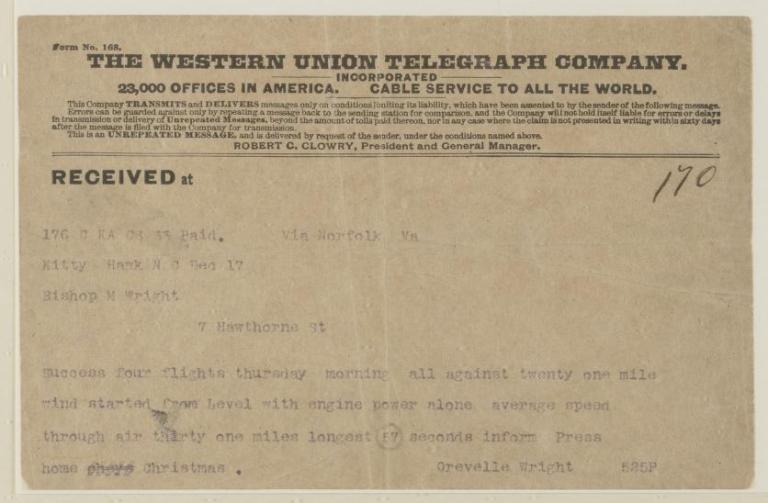
How did they describe accomplishing the impossible?
Success.
Not, “we flew,” “we did it,” or even “flight,” but “Success.”
They recognized precisely when they reached their goal after four and a half years of effort and they described it with one word. Success.
For the first time since the dawn of creation humanity’s dream of flight was realized. The impossible was made possible. Two simple, hard working men accomplished the impossible with the right characteristics – the Wright characteristics.
“Act boldly and unseen forces will come to your aid,” said author Dorothea Brande. Those “unseen forces” are what most people call luck. But when you’re curious, confident, collaborative, creative, courageous, dedicated, efficient, humorous, optimistic, relaxed and self-reliant these are the unseen forces that come to your aid when you act boldly.
These characteristics are in you, waiting to help you realize your dream and accomplish the impossible.
The telegram Will and Orv sent that afternoon is the inspiration and the core of this book. They did the impossible and then pronounced it a success. The Wright brothers set a goal that nearly everyone in the world considered impossible. They worked towards that goal tirelessly for nearly five years.
And when they reached their goal: Success. Now it’s your turn.
Follow this link to order a signed copy of Soar to Success the Wright Way or Jim’s novel: Faith, Hope, and Baseball.
Ω
Pastor Jim Meisner, Jr. is the author of the novel Faith, Hope, and Baseball, available on Amazon, or follow this link to order an autographed copy. He created and manages the Facebook page Faith on the Fringe.


